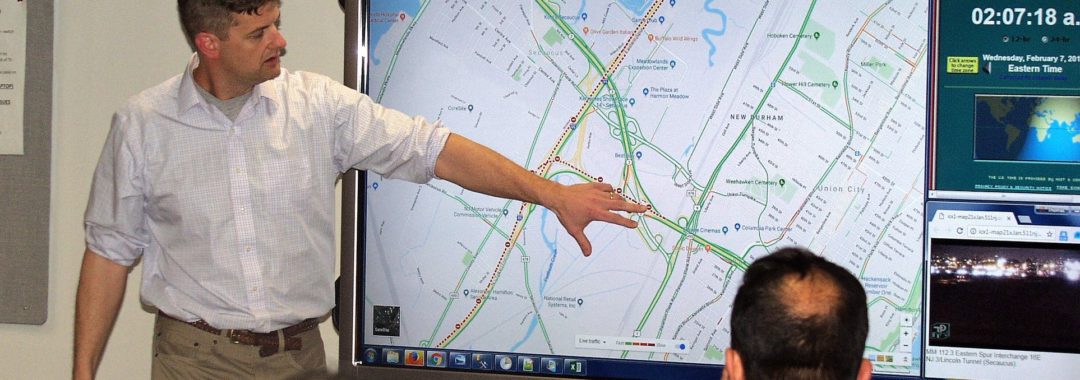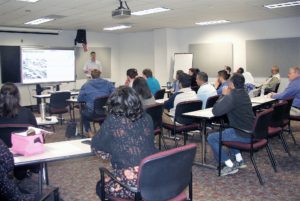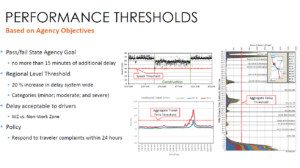In honor of Work Zone Safety Awareness Week, the NJDOT Bureau of Research hosted a Lunchtime Tech Talk, “Making Work Zones Smarter: Data-Driven Decision Making” on April 11th. Dr. Thomas M. Brennan from The College of New Jersey discussed his research using probe vehicle data – that is, anonymous vehicle speed data — to inform the development of work zone mobility performance measures and “Smart Work Zone” congestion management strategies.
An important goal of Dr. Brennan’s research has been the development of mobility performance measures that align with the transportation agency’s goals to improve reliability and speeds and diminish delays, queuing, and user costs. In his talk, Dr. Brennan demonstrated how probe vehicle data collected from a public agency or commercial vendor can be converted from its raw form into mobility performance measures and compelling visualizations for decision-makers to use in formulating appropriate work zone policies and procedures.
He outlined a case study design framework and the steps needed for analyzing work zone effects on mobility performance measures. He described the types of information needed to conduct a work zone mobility audit, including traffic flow and work zone activity data. Using anonymous vehicle speed data, information about traffic slowdowns within the designated area can be gathered. With enough data points stored over time – and with the appropriate performance measures and visualizations – it is possible to evaluate whether a work zone is increasing congestion as a result of the roadway system, as a result of the type of construction being undertaken, or some combination of both.
Dr. Brennan described the research he has performed in work zones in both Indiana and New Jersey, including an example of road closures of Route 80 in New Jersey. He found that, by gathering speed data alone, one could make an informed observation on when road work was being done and the effects on the surrounding road system. The data measured the impacts of work zones before, during, and after a project’s completion, showing the total “life-cycle” effect of a work zone.
Dr. Brennan noted several types of decisions that state agencies must make to implement a data-driven approach to work zone management. For example, state agencies will need to select the types of work zones to apply the information, determine appropriate performance measures, define appropriate criteria for “congestion” thresholds, establish the right level of geographic detail and frequency for monitoring and measuring performance, and identify strategies to manage poorly performing work zones. High-level agency strategies must also be put in place for efficiently archiving the various data that is collected, defining appropriate agency-wide performance measures and standards, and whether to incentivize contractors based on mobility performance measures, among other considerations.
During the course of the talk, Dr. Brennan highlighted various ways in which probe vehicle data can be used to characterize the reliability, resiliency and congestion at the regional and granular level to inform work zone planning. He hopes to use traffic flow data and work zone activity data to develop a comprehensive guide on how best to predict future congestion. Such data would combine the type of work zone (e.g., lane closures, patching, ramp closures, etc.) with archived data showing how previous similar events had affected the road system. This information could be used to provide agencies with alternative designs for future work zones, and provide drivers with alternative routes, thereby improving the safety and capacity of a work zone for workers and travelers alike.
Resources
Brennan, T. (2019). Making Work Zones Smarter: Data Driven Decision Making (Presentation)
Brennan, T. M., Venigalla, M. M., Hyde, A., & LaRegina, A. (2018). Performance Measures for Characterizing Regional Congestion using Aggregated Multi-Year Probe Vehicle Data. Transportation Research Record, 2672(42), 170–179. https://doi.org/10.1177/0361198118797190
Remias, S., T. Brennan, C. Day, H. Summers, E. Cox, D. Horton, and D. Bullock (2013). 2012 Indiana Mobility Report: Full Version. https://docs.lib.purdue.edu/imr/4/



